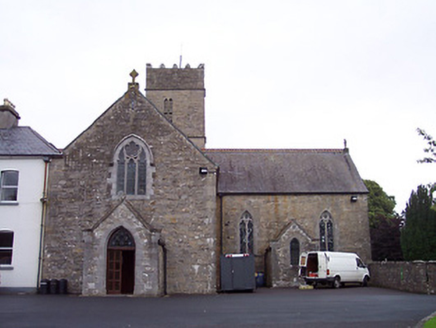Survey Data
Reg No
15304013
Rating
Regional
Categories of Special Interest
Archaeological, Architectural, Artistic, Historical, Social
Original Use
Abbey
In Use As
Abbey
Date
1300 - 1840
Coordinates
240295, 264426
Date Recorded
30/07/2004
Date Updated
--/--/--
Description
Attached Franciscan abbey, originally built c.1306, extended c.1450 with addition of crossing tower and transept (south), abandoned c.1650. Largely rebuilt from ruins c.1830 and renovated, c.1880, and extended and reordered c.1975, with reconstruction of chancel and addition of a modern sanctuary. Now comprising single-bay nave, two-bay chancel, two-bay transept to south and central three-stage crossing tower on square plan with battlemented parapet with Irish-style crenellations. Single-bay gable-fronted entrance porches to west end of nave and to west side of south transept. Pitched natural slate roofs with raised verges with stone coping, clay ridge tiles and cast-iron rainwater goods. Stone cross finials to nave and transept gables, decorative terracotta ridge cresting to transept. Constructed of coursed limestone rubble with cut limestone surrounds to openings and dressed limestone detailing. Pointed-arched openings with cut-stone tracery and hoodmouldings over. Single triple-light medieval window, c.1450, with reticulated tracery to transept gable. Window to chancel gable taken from Presbyterian church at Tully, Co. Longford and built into new chancel, c.1975. Pointed-arch opening to entrances porches with replacement glazed timber doors and overlights with stained glass over. Paired ogee-headed openings to belfry (second stage of crossing tower) with timber louvered vents. Church interior now stripped of any early render/plaster with exposed rubble limestone walls. A number of (moved) inscribed early seventeenth century memorial slabs remain to interior. Set back from road in mature landscaped grounds with monastery to north, a walled graveyard to south and gardens to west with stations of the cross.
Appraisal
This restored medieval abbey is of immense historical and architectural importance, the distinctively slender tower and the medieval window to the gable of the south transept being the most important of the surviving medieval features. It is one of the few medieval religious foundations that is still in active use in Ireland today. The church complex now has a mid-to-late nineteenth-century Gothic Revival feel on account of the extensive rebuilding programme carried out by the Franciscan community after they returned to the site following Catholic Emancipation (1827). The interior of the church has been seriously compromised by the removal of any surviving early render or plasterwork during the c. 1975 alterations. A number of the mid twentieth-century stained glass windows were created by Richard King (1907-1974), a noted artist and a studio manager with the Harry Clarke Studio in the 1930s. This interesting religious complex has a long and colourful history. It was originally built for the Franciscan community under the patronage of William Delayer of Street in 1306. The community suffered frequent raids by the English authorities between c. 1540 and c. 1650. The site was finally abandoned following the Cromwellian Wars c. 1650 but was re-established at nearby Knightswood (near Ballynafid). The Franciscans returned to Multyfarnham in 1827 and began the work of restoring what was then a roofless ruin. The nave now contains a number of interesting seventeenth century memorials, which were probably originally part of the former chancel. One of these memorials is to William Delamer and family of Street with inscription, 'Wm Delamer erected this tomb for himself and family AD 1684 whose predecessor Wm Delamer of Streete a soldier founded and built this monastery AD 1306'. This multi-layered church remains an integral component of the architectural heritage of Westmeath and forms the centrepiece of an important group of structures within the Franciscan Friary complex.







